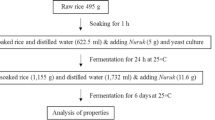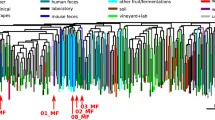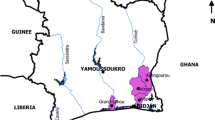Abstract
The industrial use of starter cultures containing a consortium of different strains from the same species is nowadays seen as a possible strategy to enhance the organoleptic complexity of wines. To assess the relative contribution of each strain to the final product it is essential to quantify population evolution during the wine fermentation process, which requires strain-specific methods to identify and differentiate each strain. In the present study, a molecular method based on analysis of the polymorphisms exhibited by the PCR-amplification of the delta regions of three Saccharomyces cerevisiae strains was developed. A set of three pairs of primers (delta1–delta2, delta12–delta2, delta12–delta21) was used for each strain, and analysis of the resulting polymorphism patterns showed that the delta12–delta2 primer pair exhibited the highest resolution and discriminatory power. Thus, this pair of primers was selected to monitor the population evolution of a laboratory-scale wine fermentation performed in synthetic grape juice that was inoculated with similar amounts of each strain. The results showed that all strains grew together during the exponential growth phase (2–3 days) and maintained high cell density values (106–107 cfu ml−1) throughout the stationary growth phase without significantly changing their relative population proportion, thus indicating that each strain can influence the chemical composition and final flavor of wine, albeit at different levels. This study also showed that PCR-amplification of DNA delta sequences of S. cerevisiae strains is a reproducible, strain-specific and simple method that can be used successfully to monitor yeast strain population dynamics during wine fermentations.



Similar content being viewed by others
References
Azumi M, Yamamoto N (2001) AFLP analysis of type strains and laboratory and industrial strains of Saccharomyces cerevisiae sensu stricto and its application to the phenetic clustering. Yeast 18:1145–1154
Bidenne C, Blondin B, Dequin S, Vezinhet F (1992) Analysis of the chromosomal DNA polymorphism of wine strains of Saccharomyces cerevisiae. Curr Genet 22:1–7
Cameron JR, Loh EY, Davis RW (1979) Evidence for transposition of dispersed repetitive DNA families in yeast. Cell 16:739–751
de Barros Lopes M, Rainieri S, Henschke PA, Langridge P (1999) AFLP fingerprinting for analysis of yeast genetic variation. Int J Syst Bacteriol 49:915–924
de Barros Lopes M, Sonden A, Martens AL, Henschke PA, Langridge P (1998) Differentiation and species identification of yeasts using PCR. Int J Syst Bacteriol 48:279–286
Degré R, Thomas DY, Ash J, Mailhiot K, Morin A, Dubord C (1989) Wine yeasts strain identification. Am J Enol Vitic 40:309–315
Gonzalez Techera A, Jubany S, Carrau FM, Gaggero C (2001) Differentiation of industrial wine yeast strains using microsatellite markers. Lett Appl Microbiol 33:71–75
Howell KS, Bartowsky EJ, Henschke PA (2004) Microsatellite PCR profiling of Saccharomyces cerevisiae strains during wine fermentation. Lett Appl Microbiol 38:315–320
Howell KS, Cozzolino D, Bartowsky EJ, Fleet GH, Henschke PA (2006) Metabolic profiling as a tool for revealing Saccharomyces interactions during wine fermentation. FEMS Yeast Res 6:91–100
Jubany S, Tomasco I, de Leon IP, Medina K, Carrau F, Arrambide N, Naya H, Gaggero C (2008) Toward a global database for the molecular typing of Saccharomyces cerevisiae strains. FEMS Yeast Res 8:472–484
Kishimoto M, Soma E, Goto S (1994) Classification of cryophilic wine yeasts based on electrophoretic karyotype, G + C content and DNA similarity. J Gen Appl Microbiol 40:83–93
Legras J, Karst F (2003) Optimisation of interdelta analysis for Saccharomyces cerevisiae strain characterization. FEMS Microbiol Lett 221:249–255
Ness F, Lavalle F, Dubourdieu D, Aigle M, Dulau L (1993) Identification of yeast strains using the polymerase chain reaction. J Sci Food Agric 62:89–94
Perez-Nevado F, Albergaria H, Hogg T, Girio F (2006) Cellular death of two non-Saccharomyces wine-related yeasts during mixed fermentations with Saccharomyces cerevisiae. Int J Food Microbiol 108:336–345
Pretorius IS (2000) Tailoring wine yeast for the new millennium: novel approaches to the ancient art of winemaking. Yeast 16:675–729
Querol A, Barrio E, Huerta T, Ramon D (1992) Molecular monitoring of wine fermentations conducted by active dry yeast strains. Appl Environ Microbiol 58:2948–2953
Quesada MP, Cenis JL (1995) Use of random amplified polymorphic DNA (RAPD-PCR) in the characterization of wine yeasts. Am J Enol Vitic 46:204–208
Romano P, Fiore C, Paraggio M, Caruso M, Capece A (2003) Function of yeast species and strains in wine flavour. Int J Food Microbiol 86:169–180
Schuller D, Valero E, Dequin S, Casal M (2004) Survey of molecular methods for the typing of wine yeast strains. FEMS Microbiol Lett 231:19–26
Torriani S, Zapparoli G, Suzzi G (1999) Genetic and phenotypic diversity of Saccharomyces sensu stricto strains isolated from Amarone wine Diversity of Saccharomyces strains from Amarone wine. Antonie Van Leeuwenhoek 75:207–215
Van Der Westhuizen TJ, Pretorius IS (1992) The value of electrophoretic fingerprinting and karyotyping in wine yeast breeding programs. Antonie Van Leeuwenhoek 61:249–256
Vaudano E, Garcia-Moruno E (2008) Discrimination of Saccharomyces cerevisiae wine strains using microsatellite multiplex PCR and band pattern analysis. Food Microbiol 25:56–64
Xufre A, Simões F, Gírio F, Clemente A, Amaral-Collaço MT (2000) Use of RAPD analysis for differentiation among six enological Saccharomyces spp .strains. Food Technol Biotechnol 38:53–58
Acknowledgments
The present work was supported by project POCTI/AGR/39974/2001. A.X. was a beneficiary of a PhD fellowship (Praxis XXI/BD/21366/99) funded by Fundação para a Ciência e Tecnologia, Portugal. The authors would like to express their gratitude to João Inácio for his review of the paper.
Author information
Authors and Affiliations
Corresponding author
Additional information
This article is part of the BioMicroWorld 2009 Special Issue.
Isabel Spencer-Martins: Deceased.
Rights and permissions
About this article
Cite this article
Xufre, A., Albergaria, H., Gírio, F. et al. Use of interdelta polymorphisms of Saccharomyces cerevisiae strains to monitor population evolution during wine fermentation. J Ind Microbiol Biotechnol 38, 127–132 (2011). https://doi.org/10.1007/s10295-010-0837-z
Received:
Accepted:
Published:
Issue Date:
DOI: https://doi.org/10.1007/s10295-010-0837-z




